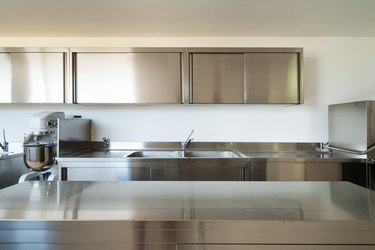
If you have a three-compartment sink at home or at your place of business, you may need to repair it at some point. Plumbing a three-compartment sink can be a bit more complicated than working with a normal sink. Fortunately, it's fairly easy to repair sinks like these once you know how their pipes are laid out.
Kitchen Sink Basics
Video of the Day
Three-compartment sinks are most often used in restaurants to deep clean and sanitize dishes. While some eateries use dish machines and dishwashers, the manual three-sink method is effective and accepted by most health departments. The first bay is where the dishes are washed with detergent. In the second, they are rinsed with hot water and in the third, they are rinsed with a sanitizing solution to kill any remaining bacteria.
Video of the Day
Kitchen sinks are routed and connected to the main water supply system. They are designed to be hooked up to garbage disposals, water filters and other similar fixtures. Sinks drain their water through strainers in the sink's holes, and this then travels down the drain's tailpiece and into the plumbing.
Once a triple-compartment sink is installed, you can either hire a plumber or do it yourself. The first step is to get in touch with the local inspector to see if there are any construction codes that apply. Once you have the parts you need, you should turn off the water supply valves that are located under the sinks and protect the areas with buckets in case there is standing water in the pipes.
Plumbing the Sink
Use a pipe wrench to take apart the old plumbing. Three-piece kitchen sink pipe kits may have a center section for the middle drain and two longer elbow sections for the right and left sinks. There should also be two drain tailpieces. Separate the parts on the floor before moving on to the next stage. If your kit has fewer pieces than this, you may need to combine several kits or buy pieces individually.
Test where the horizontal parts of the kit will fit beneath the sink. The center section and elbow sections can be dry fitted. You will need to use a hacksaw to cut the pieces as needed.
Next, you will install the P-trap. These pipes hold a small amount of water to prevent sewer gas from entering the kitchen. If the wall drain is set in the center, you may be able to install your P-trap without a flexible drain extension; these are used to curve the flow to line up with the wall drain.
Finishing the Installation
Finally, you can install the tailpiece extensions to the bottom of the sink drains. You may not need to do this, but read the instructions with your kit to make sure. Be sure to carefully tighten all of the connections once you are finished and add plumber's tape (also called thread sealing tape). Then, you can try running the water to test for leaks.
Do not turn on the water too strongly to test for leaks, as this could create a mess. Inspect your work with a flashlight with the water running slowly. If you find water leaking, you may need to tighten the connections. Should this not work, you may have to take the plumbing apart to find the source of the problem.